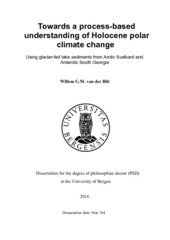| dc.description.abstract | Earth`s polar regions are undergoing dramatic changes due to ongoing climate change as demonstrated by increasing temperatures, collapsing ice shelves, Arctic sea ice loss and rapid glacier retreat. Driving an accelerating rise in global sea level, this amplified regional response may have devastating global socio-economic consequences in the foreseeable future. Yet the causes and range of polar climate variability remain poorly understood as observational records are short and fragmentary, while climate proxy timeseries remain scarce and often lack resolution. More detailed and longer paleoclimate archives are urgently needed to allow assessment of the full envelope of natural polar climate variability. This would allow us to contextualise ongoing warming and help improve policy scenarios, in effect using the past as the key to both present and future. Glaciers are sensitive recorders of climate variability as demonstrated by their response to ongoing global change. In addition to changes in size, this response is also captured by variations in glacial erosion in alpine glacier systems. The finest constituent of this process, known as glacial flour, is suspended in meltwater streams and may be deposited in downstream lakes. Hence, the bottom sediments of such glacier-fed lakes are continuous archives of past glacier activity and thus represent prime targets for paleoclimate studies. In this thesis, the paleoclimatic potential of glacier-fed lake sediments is harnessed to improve our understanding of past polar climate change. To this end, sensitive sites on Arctic Svalbard and Antarctic South Georgia, in the pathways of major regional circulation patterns, were targeted. Emphasis is placed on the present Holocene interglacial as it is characterised by climatic boundary conditions that are similar to the present. A targeted multi-proxy approach, concentrating on geomorphological mapping, sediment fingerprinting, paleothermometry and advanced numerical techniques, was employed to enhance the potential of glacier-fed lakes as paleoclimate archives. Also, site-specific findings were contextualised through integration in a wider regional paleoclimate framework. This thesis presents the first full Holocene records of glacier variability and summer temperature on Svalbard, in addition to the first continuous reconstruction of Late Holocene glacier Equilibrium Line Altitude (ELA) in the sub-Antarctic. The reported findings indicate a dynamic Holocene climate history of Svalbard, characterised by 1) pervasive Early Holocene glacial meltwater cooling, delaying the Hypsithermal until ± 7 ka BP and culminating in a glacier maximum, 2) a two-stage inception of the Neoglacial between ± 7-5 ka BP, driven by the strengthening influence of Arctic water and sea-ice against a backdrop of decreasing summer insolation and 3) a changeable Neoglacial from 4 ka BP onwards, characterised by a mean cold climate state that was perturbed by centennial-scale temperature excursions and glacial advances that were driven by the interaction between oceanic (AMOC), atmospheric (NAO) and solar forcing. This study shows that Late Holocene climate on South Georgia responded intricate transient phase-dependent interactions between regional circulation patterns (SWW, SAM and ENSO). In addition to these regional forcings, the reconstructed bi-polar expression of the Little Ice Age (LIA) and observed response to recent warming demonstrate the imprint of global forcing(s). Notwithstanding limitations posed by e.g. closed-sum effects on proxy measurements as well as analytical and chronological uncertainties, this work advances our knowledge on Holocene polar climate variability, providing a reference to assess ongoing change. In addition to expanding the spatio-temporal coverage of high latitude proxy archives, future research should focus on 1) the integration of geomorphological mapping and sediment fingerprinting to constrain the signature of lake sedimentation, 2) the development of advanced ELA models in tandem with the application of paleothermometry to constrain the impact of atmosphere-driven shifts in hydroclimate and 3) the application of novel numerical tools to improve the robustness of glacier-fed lake-based paleoclimate studies. Prime examples include integration with model scenarios and instrumental calibration. | en_US |
